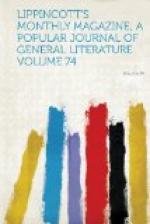We cross over to this building when the stable-door has been locked and watch the eager crowd which is waiting for the weekly “’lowance.” Sturdy, strapping women, with muscular arms and stout calves freely displayed under the skirts which are tucked around their waists, are standing in picturesque attitudes or sitting on their upturned baskets, while ragged, wild-looking little “picknies” are clinging to the said skirts and peeping with great staring eyes at the strange “buckrah man.” Each will take the week’s supply of ear-corn and potatoes for her household—a peck for each member of the family, large and small—and will grind her own grist at the mill-house, or more probably trade away the entire supply at the cross-roads store for flour, sugar and coffee.
“Why, Rose, is that you? How are you, and how are the children?”
“De Lawd! Wha’ dat? who dat da’ talk me? Bless de Lawd! da’ nyoung maussa! Ki! enty you tek wife yet? Go ’way! Look! he done got bayd (beard) same like ole nanny-goat! Bless de Lawd!”
“I’m glad to see you looking so young, Kitty: your children must be grown up.”
“Tenk de Lawd, maussa,” with a low curtsey, “I day yah yet! Dem pickny, da big man an’ ‘oman now. Enty you got one piece t’bacca fo’ po’ ole nigger?”
The tobacco is forthcoming, together with a few gaudy head-handkerchiefs and little parcels of sugar, and “nyoung maussa” has it all his own way with the simple creatures. These negroes are as near the original wild African type as if a few years instead of more than a century of contact with civilization had passed over them. They are all the direct descendants of original importations, chiefly Ghoolahs and Ashantees; indeed, “Gullah niggah” is a favorite term of playful reproach among them. Their male names are still largely Ashantee, as “Cudjo,” “Cuffee,” “Quarcoo,” “Quashee,” etc., and their dialect, a mixture of “pigeon English” and Ghoolah, strongly impregnated with the French of the Huguenot masters of their forefathers, is simply incomprehensible to a stranger, whether white or black. Indeed, when excited and talking rapidly even those who have grown up among them can scarcely understand the lingo. “Coom, Hondree,” says an old nurse to her little charge at bedtime, “le’ we tek fire go atop:” in English, “Come, Henry, let’s take a light and go up stairs.” “Child” is “pickny;” “white man” (or woman), “buckrah;” “I don’t know,” “Me no sabbee;” “Is it not?” “Enty?”; “watermelon” is “attermillion” or “mutwilliam;” and so on.
Paying a medical visit, I enter a house where the patient is a sick child: the old crone who is sitting in the doorway with a boy’s head between her knees, performing the office of which monkeys are so fond, calls out, “Lindy! de buckrah coom.”
“What’s the matter with the child?” I inquire.
“Ki, maussa! me no sabbee wha’ do a pickny,” replies the intelligent Lindy, who wishes me to know that she knows nothing about the case.




